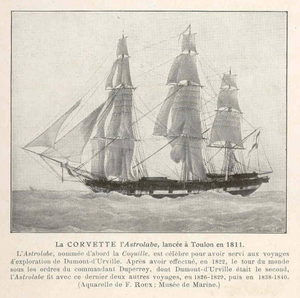L'Astrolabe
 |
|
| History | |
|---|---|
|
|
|
| Namesake: | French ship Astrolabe |
| Builder: | Toulon shipyard |
| Launched: | 1811 |
| Christened: | Coquille, 9 July 1814 |
| Renamed: | Astrolabe in 1826 |
| Fate: | Scrapped in 1851 |
| General characteristics | |
| Class and type: | Fluyt |
| Displacement: | 380 tonnes |
| Length: | 31.57 m (103.6 ft) |
| Beam: | 18.48 m (60.6 ft) |
| Draught: | 4.25 m (13.9 ft) |
| Propulsion: | Sail |
| Armour: | timber |
The Astrolabe was a horse barge converted to an exploration ship of the French Navy and was originally named Coquille. She is famous for her travels with Jules Dumont d'Urville. The name derives from an early navigational instrument, the astrolabe, a precursor to the sextant.
Louis Isidore Duperrey commanded Coquille on its circumnavigation of the earth (1822–1825) with Jules Dumont d'Urville as second. René-Primevère Lesson also travelled on Coquille as a naval doctor and naturalist. On the return to France in March 1825, Lesson and Dumont brought back to France an imposing collection of animals and plants collected on the Falkland Islands, on the coasts of Chile and Peru, in the archipelagos of the Pacific and New Zealand, New Guinea and Australia.
During the voyage the ship spent two weeks in the Bay of Islands in the north of New Zealand in 1824. On the return voyage to France the ship sailed through the Ellice Islands (now known as Tuvalu).
Coquille was renamed the Astrolabe in honour of one of the ships of La Pérouse, and sailed from Toulon on 22 April 1826, towards the Pacific Ocean, for a circumnavigation of the world that was destined to last nearly three years.
The Astrolabe explored parts of New Zealand. In January 1827, the French explorer Dumont d'Urville arrived in Tasman Bay in the north of the South Island. A number of landmarks around Tasman Bay were named by d'Urville and his crew including d'Urville Island, French Pass and Torrent Bay. Dumont then sailed along the east coast of the North Island. On 12 March 1827 Astrolabe entered the Bay of Islands.
...
Wikipedia
